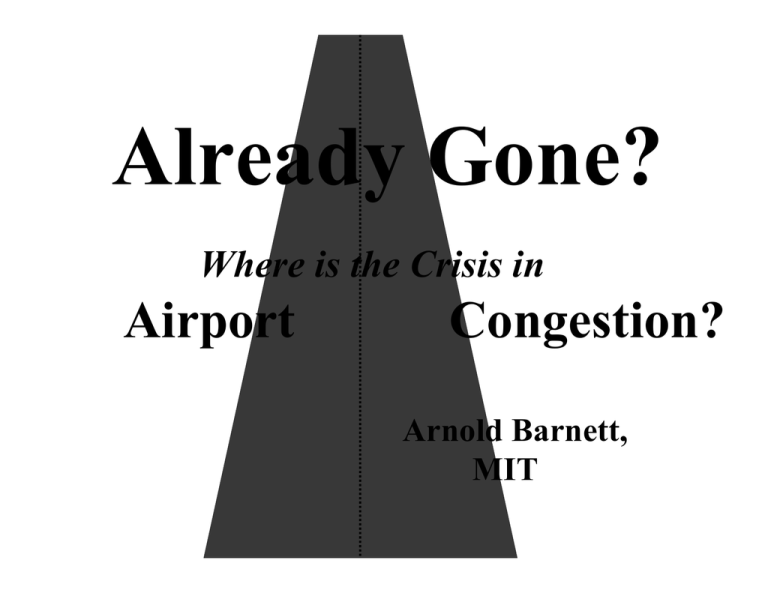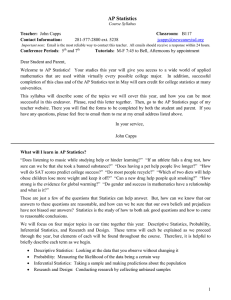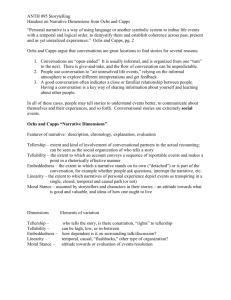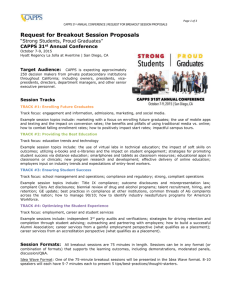Already Gone? Airport Congestion? Where is the Crisis in
advertisement

Already Gone? Where is the Crisis in Airport Congestion? Arnold Barnett, MIT The Overall Pattern: • Fewer operations in 2001 than in 2000 •Fewer operations in 2002 than in 2001 •Fewer operations in 2003 than in 2002 •No projected increases in 2004 We focus here on: (1) Airports (2) Congestion at Hubs (3) Commercial Flights Several forces are acting simultaneously to diminish congestion at hubs: • Hub activities of network carriers • Activities elsewhere of low-cost carriers • The proliferation of regional jets The network airlines have begun taking steps that should work against hub congestion: • “Depeaking” of Hub Operations • Withdrawal of “Excess Capacity” Secondary Airports: A Surprisingly Close Second Origin/Destination Traffic between Greater Boston and Greater Washington in Two Periods Airports Primary/Primary Primary/Secondary Secondary/Secondary Mid-1996 68% 26% 6% Mid-2002 34% 26% 40% Primary: BOS/DCA,IAD Secondary:PVD,MHT/BWI Origin/Destination Traffic between Greater Los Angeles and the Bay Area, 2nd Quarter 2002 Airports Primary/Primary Primary/Secondary Secondary/Secondary Share of Traffic 27% 46% 28% Primary:LAX, SFO Secondary:OAK,BUR Estimated Split of New York City Traffic Between Two Southern California Airports, Spring 2003 LAX NYC 62% LGB NYC 38% (Point-to-Point Passengers; LGB = Long Beach) What Other Secondary Airports Could Bloom? Gary, Indiana? Regional Jets: Nonstop from Here to There Examples: BOS-JAX (DL) FLL-RDU (DL) (No ATL or especially CLT) (Ditto) And, of course, air traffic growth would be affected by further terrorism against airplanes. Could 9/11 happen again? “With the amount of security that we have in the aviation system today, the likelihood of a terrorist using aviation as the venue for future attack is very low.” --Donald Carty, CEO, American Airlines, mid-2002 Maybe, but the terrorists have always been fascinated by aviation: On a per-hour basis, US citizens are about 400 times as likely to be killed by terrorists during a journey by air as at other times. And this statistic, prepared by my student Susan Martonosi….. is based exclusively on data prior to 9/11. The Transportation Security Administration (TSA) has done some very good things. In recent months, however, it has abolished several security measures for reasons that are not easy to fathom. Why are the two baggagesecurity questions (“Has Anyone Unknown to You..”) now asked of no one rather than everyone? Why don’t they check photo ID’s at the boarding gate anymore? Why did they end positive passenger bag match (PPBM) when they extended physical screening to all checked bags? Why have they resumed transporting heavier US mail on US passenger planes? “TSA launched the joint pilot program…with the goal to increase the volume of mail carried on passenger aircraft to the same or greater levels that were transported prior to September 11, 2001.” Is it appropriate for TSA to adopt such a purely economic objective? CAPPS II: The Perfect Storm? CAPPS (Computer-Assisted Passenger Prescreening System) partitions passengers into two main groups: •Selectees, who get intense airport screening •Non-selectees, who are screened less CAPPS II has friends in high places: “the foundation of aviation security” --DOT Secretary Norman Mineta “the right answer to security” --American Airlines CEO Carty “the most important single project on TSA’s current agenda” --TSA spokesman CAPPS II will relay heavily on “data mining,” which is-roughly speaking--a high speed trial and error search through existing data for important patterns and correlations. The limits of data mining in this context were suggested in the Washington sniper crisis, when experts who “mined” data about previous serial killers strongly believed that the perpetrators were white. “There is no clear profile anymore, not for terrorists and especially not for suicide bombers.” --Senior Officer, Israeli Defense Forces Some MIT students have written a paper about how to “defeat” CAPPS. Stung by charges that CAPPS II would involve ethnic profiling and would violate personal privacy, TSA may be modifying the system in ways that could degrade its predictive accuracy. Despite all this, CAPPS II could yield security improvements over CAPPS I under two conditions: • the fraction of passengers designated selectees does not decline • security processing does not slacken for either selectees or non-selectees Unfortunately, neither of these conditions is likely to be satisfied. TSA has stated that: • travelers “may well notice” that fewer passengers are selectees under CAPPS II • non-selectees under CAPPS II “clearly pose no threat of terrorism” CAPPS II might be used in ways that erode many security precautions in place today. Thus, the “foundation” of security could pose a threat to security. For various reasons, one could argue that there is an appreciable probability (at least 10% per year) of further successful terrorist acts against US domestic aviation. As noted, such acts could deeply cut the demand for air travel and airport-traffic levels. Putting everything together, we reach A Forecast: US airport congestion will not again during this decade match the levels it reached in 2000. Hub traffic in 2009 will not exceed hub traffic nine years earlier. Is the importance of the work presented at this conference contingent on a future capacity crisis? (Hint: NO)






![[4910-62] DEPARTMENT OF HOMELAND SECURITY Transportation Security Administration Docket No. DHS/TSA-2003-1](http://s2.studylib.net/store/data/013736812_1-17015f1e52a8617d7fbca72f2a8fd0de-300x300.png)